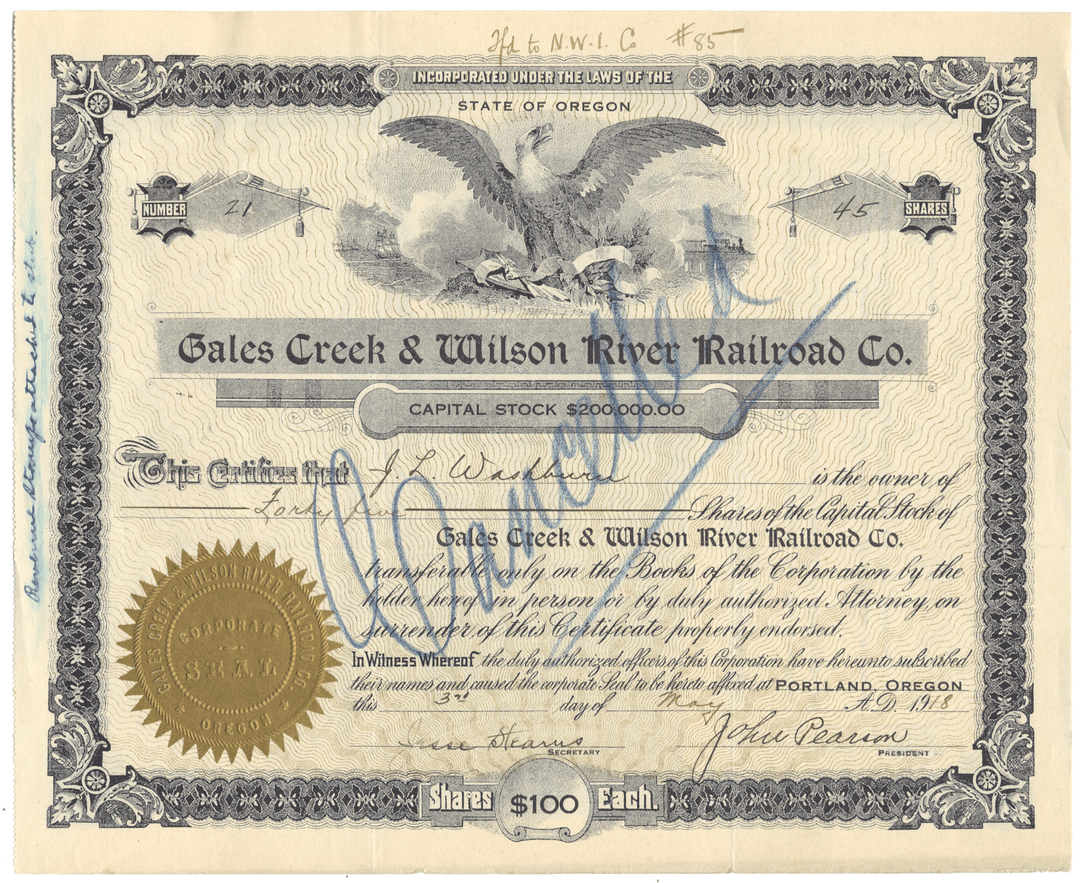
Gales Creek & Wilson River Railroad Co.
- Guaranteed authentic document
- Orders over $75 ship FREE to U. S. addresses
Product Details
Company
Gales Creek & Wilson River Railroad Company
Certificate Type
Capital Stock
Date Issued
May 3, 1918
Canceled
Yes
Printer
J. R. Rogers, Printers, Portland
Signatures
Hand signed
Approximate Size
10 1/4" (w) by 8 1/4" (h)
Images
Show the exact certificate you will receive
Guaranteed Authentic
Yes
Additional Details
NA
Reference
Historical Context
The Gales Creek & Wilson River Railroad was born out of the desire of a man name JL Washburn to reach a significant amount of timber stands his company owned west of where the United Railways line ran through Banks, Oregon. After failing to convince the UR owners to build a logging railroad, Washburn built one himself, starting in 1917.
The GC&WR left the UR and then crossed the SP Tillamook branch via a trestle and then continued west for a number of miles before turning north and finally arriving at a place called Aagaard Mill. Later known as Glenwood. The original line was about 12.74 miles long.
It took about three years to construct the line, because it was largely done with horse teams and the right of way kept getting washed out during the winter months. Also a very long high trestle had to be built over Beaver Creek, west of Orchard Dale and another significant trestle over Gales Creek, further up the line.
The GC&WR obtained 60 and 66lb used rail from the UR parent companies, the Great Northern and Northern Pacific. They also contracted out with a United Railways work train to do the track laying.
By 1920, the line was in operation. The original headquarters of the line was located at Washburn, about 9 miles up the line.
1922, a deal was struck and Washburn sold the GC&WR to the Great Northern and Northern Pacific. The GN/NP owned the United Railways and had formed the Spokane Portland & Seattle Railroad, which would over see both the UR and GC&WR, but both railroads would operate their own crews, and retain their railroad names. One of the reasons the GN/NP agreed to purchase the GC&WR - even though they didn’t really want it - was because they were afraid of the SP taking it over. One of the first things they did when they took control, was pull out the SP connection and from then on, the GC&WR only connected directly with the United Railways.
Business was slow until 1933, when the Tillamook Burn hit, scorching 11 million board feet of timber west of the end of the GC&WR railroad. This would end up being a major boom for the railroad as the timber had to salvaged as soon as possible or be lost forever from disease and rot. Three major logging companies and land holders came together to form the Consolidated Timber Company. They were the Blodgett Company, Crossett-Western and Henry F Cheney.
By 1936, the end of the GC&WR was extended a short distance to a place just west of Glenwood. From there, Consolidated Timber ran a line west into the woods and built numerous logging spurs.
For the next 10 years, logging railroad traffic would be frequent and plentiful, with as many as 4 to 6 log trains running on GC&WR at any one time. Trains would run the entire length of the GC&WR and then run on the United Railways all the way to Rafton, northwest of Portland, Oregon, where the logs would be dumped into the river.
By 1946, the Consolidated Timber Company had panned out the timber and ceased operations. Their track west of Glenwood was abandoned. With little to no traffic to handle on the GC&WR, the line was doomed. The line completely shut down at the end of 1949. By 1950, it was officially abandoned and in 1951 the tracks were pulled up.
Related Collections
Additional Information
Certificates carry no value on any of today's financial indexes and no transfer of ownership is implied. All items offered are collectible in nature only. So, you can frame them, but you can't cash them in!
All of our pieces are original - we do not sell reproductions. If you ever find out that one of our pieces is not authentic, you may return it for a full refund of the purchase price and any associated shipping charges.





